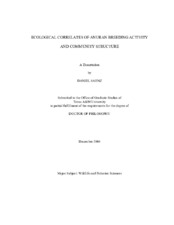| dc.contributor.advisor | Fitzgerald, Lee A. | |
| dc.creator | Saenz, Daniel | |
| dc.date.accessioned | 2005-02-17T21:06:04Z | |
| dc.date.available | 2005-02-17T21:06:04Z | |
| dc.date.created | 2004-12 | |
| dc.date.issued | 2005-02-17 | |
| dc.identifier.uri | https://hdl.handle.net/1969.1/1575 | |
| dc.description.abstract | Multiple ecological factors can simultaneously affect species activity and
community structure. The goal of my dissertation was to examine the effects of abiotic
factors, biotic factors, and succession on anuran communities. I took a three pronged
approach dividing the study into three major chapters.
First I focused on abiotic factors that affect anuran breeding activity. I found that
weather, rainfall and temperature affect the breeding activity of each species differently,
and species in my study area can be placed into 5 different groups based on their
association with weather and season: 1) breed within a predictable season (summer)
independent of local weather patterns 2) breed opportunistically within a predictable
season (summer) dependent on local rainfall 3) breed opportunistically within a
predictable season (winter) dependent on local temperature 4) breed opportunistically
dependent on local flood level rainfall events and 5) breed opportunistically year round
dependent on local temperature in the winter and local rainfall in the summer.
In the second part of the study, I created a simulation model of an anuran
community using published life history parameters of the anuran species in my study
system. Results of the model suggest colonizing ability is important for species with
low fecundity and high susceptibility to predation. These early succession species tend
to be constrained from later stages of succession by predators. Species that are resistant
to predators are generally poor colonizers and tend to arrive late in succession, but once
they colonize a pond they tend to persist and recruit successfully.
Finally, I explored biotic mechanisms that might be important in structuring
anuran communities. I found that with the exception of Rana sphenocephala, anuran
species occupying sites with shorter hydroperiods had higher activity rates and were
more susceptible to predation. Rana sphenocephala appeared to be better at escaping
predation than the other species despite a relatively high activity rate. Examination of
published phylogenies indicates R. sphenocephala is derived from a species group that
uses permanent water suggesting that R. sphenocephala has retained many anti-predator
defenses inherited from its ancestors, even though the species now exploits sites with
low predator densities. | en |
| dc.format.extent | 1871741 bytes | en |
| dc.format.medium | electronic | en |
| dc.format.mimetype | application/pdf | |
| dc.language.iso | en_US | |
| dc.publisher | Texas A&M University | |
| dc.subject | anurans | en |
| dc.subject | community assembly | en |
| dc.subject | breeding activity | en |
| dc.title | Ecological correlates of anuran breeding activity and community structure | en |
| dc.type | Book | en |
| dc.type | Thesis | en |
| thesis.degree.department | Wildlife and Fisheries Sciences | en |
| thesis.degree.discipline | Wildlife and Fisheries Sciences | en |
| thesis.degree.grantor | Texas A&M University | en |
| thesis.degree.name | Doctor of Philosophy | en |
| thesis.degree.level | Doctoral | en |
| dc.contributor.committeeMember | Winemiller, Kirk O. | |
| dc.contributor.committeeMember | Boutton, Thomas W. | |
| dc.contributor.committeeMember | Grant, William E. | |
| dc.type.genre | Electronic Dissertation | en |
| dc.type.material | text | en |
| dc.format.digitalOrigin | born digital | en |


